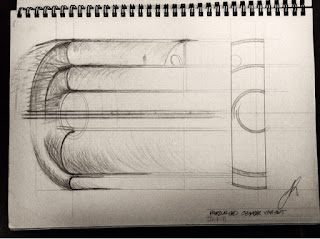Oh how I wish I could use my old but still trusty computer, I would be lacing this Blog with cgi renderings. For now I have to make do with showing some preparatory pencil sketches.
In this simple concept, chambers are like stretched out toruses and nested inside each other. This design imagines the habitat doubling as a space elevator counterweight, the tethers are the three thick lines along the centre. The overall design has to be for utility - in this case it's to have a uniform magnetic shield - and a cylinder is the easiest format for creating enclosures that will work for free-fall and rotational designs. I've drawn only one bulkhead, but I guess there could be as few or as many as one wants, and longitudinal and radial braces have to be incorporated to cope with potential bending forces and so on. These might conceivably form part of the exterior to maximise interior volume.
The exterior will not be smoothly cylindrical. Although possible, trapezoidal wedge shapes will have such subtle angles it would add complication to ensure that each and every brick is exactly the same. Better to have large flat sections that run the entire length, the exterior circumference having a polygonal aspect. At the vertices there would be transitioning bricks to make the angular change. As a result a construct could resemble the huge zeppelins of old. The end caps present the hardest problem, and are like sliced bagels. A similar tactic of flat and angular can be used.
Will a cylinder made from bricks of magnetic cast iron be strong enough to contain an atmosphere? Leaving aside leaking, since it would have a lining, the whole thing is held together by magnetism, then there is the secondary effect of cold-welding. A third mechanism is to hot weld all the joins, inside and out. Will this be strong enough? At a guess this early in my design work, I'd say yes. A fourth mechanism can be introduced, high tensile strength ribbon of the type eventually destined for lunar space elevators can be used to wrap up the exterior.
The longevity of a structure like this might conceivably run into many decades, perhaps centuries. The fixtures and fittings (life support and all that) should be designed and built for duration, some of this can be iron; refit and replacement is inevitable, but the iron hull will always be there, providing a haven within.
A blog in which are described the various designs, technologies and science of Skylance and the Next Iron Age. All content © Jay Richardson (2017 - 2019)
Subscribe to:
Posts (Atom)
Islands in the Sky, Part Three - Living Space
Oh how I wish I could use my old but still trusty computer, I would be lacing this Blog with cgi renderings. For now I have to make do with ...

-
With the last few entries I have described the basics of the Hammer technology. Now to cover what it can be used for, and also present its p...
-
Oh how I wish I could use my old but still trusty computer, I would be lacing this Blog with cgi renderings. For now I have to make do with ...
-
Constructing with magnetic bricks completely sidesteps quotidian things like nuts and bolts. No scaffolding required either. The solutions f...

